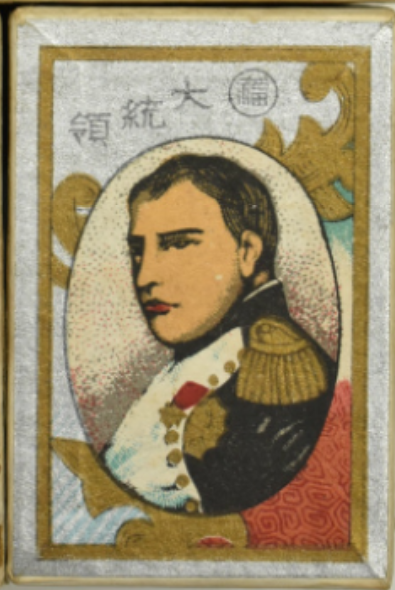
Daitoryo (大統領, lit. ‘president’) is Nintendo’s premier brand of hanafuda and kabufuda decks, and is still in use today.
It was also used as the premier brand of mekurifuda and other karuta decks in the past, until sometime in the mid 1990’s.
It is one of the most famous hanafuda brands, and is subject to parody in various character hanafuda decks.
It features a portrait of Napoleon Bonaparte, who, despite the brand name, was an Emperor, not a President. The portrait and name of Napoleon would also be used in Nintendo’s early western playing cards.
It is believed to be the first brand of hanafuda cards Nintendo has ever released since its founding in 1889, though there is no concrete evidence supporting it. The oldest surviving reference to the brand was in the Japan Patent Office Records, where the trademark was registered in 1901, one year after Taisho, Otafuku, and Masamune were registered.

Illustration of the label from the trademark submission in 1901.
In the past, it was the highest-ranking brand in Nintendo’s hanafuda lineup, followed by Taisho.
¶ Gallery
| Label | Description |
|---|---|
 |
“Shiny Nose Napoleon” Label from an unused wrapper submitted to the Japan Patent Office in 1929. |
 |
“Sad Napoleon”. Known to be used in decks from 1940-1944. |
 |
“Lipstick Napoleon”. Known to be used in decks from 1944-1946. |
 |
“Standard Napoleon”. Used intermittently since around 1944-1946 and is still in use today. |
 |
“Narrow Eyed Napoleon”. Known to be used in decks from 1947-1950. Some labels are printed in yellow and gray colors instead of gold and silver. |
 |
“Two Button Shoulder Napoleon”. Date Unknown, probably early 1950’s. |
 |
“Wavy Hair Napoleon”. Known to be used in decks from the 1950’s. |
 |
“Impostor Napoleon”. Known to be used in decks from the early 1970’s. Portrait looks absolutely nothing like Napoleon Bonaparte. |
 |
“Smirking Napoleon”. Known to be used in two-deck wooden box sets from 1977-1978. The label is completely redesigned, and the brand is now written left-to-right instead of right-to-left. |
 |
Used in five-deck ream boxes from the 1960’s and 1970’s. |
¶ Brand Line Up (Current)
¶ Hanafuda
- Daitoryo
- Tengu
- Miyako No Hana, Chiyozakura
¶ Kabufuda
- Daitoryo
¶ Brand Line Up (1930’s Catalog)
¶ Hanafuda
- Daitoryo
- Taisho
- Otafuku
- Masamune
- Shiko jirushi
- Ginsekai
- Chujo
- Asahi Sakura, Kintengu
- Marufuku jirushi
- Yaezakura, Kikusui, Gintengu
- Konishiki jirushi
- Kikumaku
- Tokiwa
- Hatsuzakura
- Hyaku-en
- Hi No De
- Hana No Yama
- Miyako No Hana
¶ Mushibana
¶ Bibliography
- https://dl.ndl.go.jp/pid/845526 Tokyo Shoin (1905)